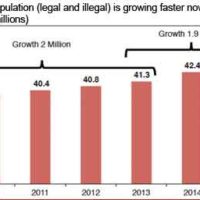New NPG Report Shows Foreign-Born Population Growing as U.S. Economy Improves
- NPG
- November 15, 2016
- Press Releases
- 0 Comments
 Your gift helps publish and distribute materials like this.
Your gift helps publish and distribute materials like this.
Download a PDF of this release here.
New NPG Report Shows Foreign-Born Population Growing as U.S. Economy Improves
Analysis of Census Bureau data shows immigration, not natural increase, is projected to become main source of U.S. population growth as early as 2023.
Alexandria, VA – According to the most recent U.S. Census Bureau projections, by 2060 our nation’s population is “projected to increase… to 417 million, reaching 400 million in 2051.” Census also found that “by 2060, nearly one in five of the nation’s total population is projected to be foreign born.” Today, Negative Population Growth (NPG) has released a new Forum paper titled Growth of Foreign-Born Population Surges as U.S. Economy Recovers. The NPG report asserts that the significant increases of the foreign-born population, which are highlighted in Census’ figures, confirm that immigration has not lost its momentum – even during America’s worst recession since the 1930s – and as early as 2023 may displace natural increase as the main driver of U.S. population growth.
NPG Senior Advisor David Simcox, who authored the Forum paper, explains: “What is apparent in these numbers is the mechanistic and rigid nature of the U.S. legal immigration system: it continued intake of 1.0 million to 1.1 million or more newcomers yearly between 2007 and 2014… These numbers of legal admissions show little decline in legal immigration during the hard times of the past decade.” He adds: “The U.S. legal immigration system has become a mindless machine, with no ‘slow’ or ‘stop’ button – only ‘full ahead.’”
Simcox’s report assesses the domestic and international factors that now keep immigration high and growing. He notes: “Present and prospective conditions in the world and within the U.S. suggest that net immigration to the U.S. between now and 2060 will be closer to the 1.5 million to 2.0 million annual range… The world-wide demand for settlement in the U.S. is astronomical, and the prevailing attitude of America’s political elites is acquiescence.” As the world continues to add more people, the U.S. will only see more of this migration. Simcox adds: “World population trends are likely to nourish continued growth in the overseas millions seeking to settle in the U.S. …In ruling political sectors of the U.S. there is indifference to these population trends or, all too often, a view of them as beneficial….”
Simcox concludes: “Even without legal expansion of immigration, rising numbers are built into the existing laws and practices. …And over time, Washington has developed myriad ways to admit people to the U.S. other than through rationed legal immigration visas… Events within the U.S. and grave trends beyond its borders between now and mid-century will go far in determining whether the U.S. can recognize and act on the vital need for a rigorous balance between its population and its environmental and resource limits.”
In response to the new Forum paper, NPG President Don Mann states: “Americans must remember that the U.S. is the world’s most overpopulated nation, in terms of the massive demands on its resources. High immigration is distancing Americans from what should be an urgent national goal: population stability, followed by reduction of the national population to a level consistent with long-term sustainability and environmental health.” Mann appealed again for ending immigration’s role as a major population booster, calling for a commitment to zero-net migration, or about 200,000 admissions a year.

